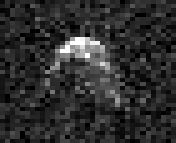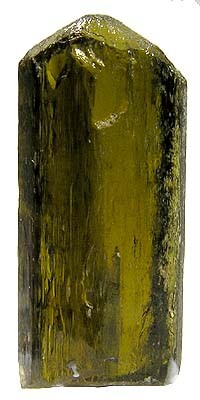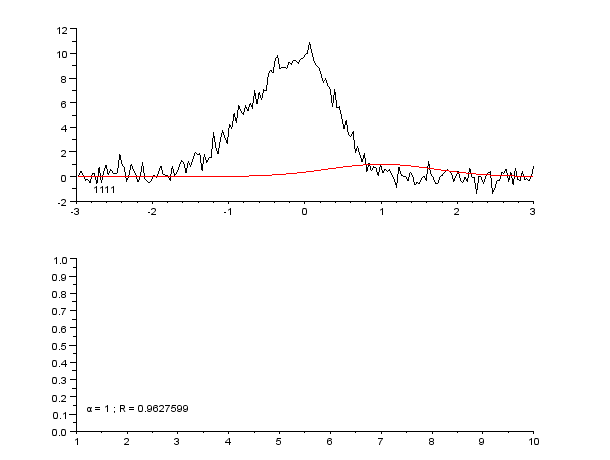|
4660 Nereus
4660 Nereus, provisional designation 1982 DB, is a small (about ) asteroid. It was discovered by Eleanor F. Helin on 28 February 1982, approximately a month after it passed from Earth. Nereus is potentially an important asteroid with a high albedo. It is an Apollo and Mars-crosser, with an orbit that frequently comes close to Earth, and because of this it is exceptionally accessible to spacecraft. Indeed, because of its small size and close orbit, its delta-V for rendezvous of ~5 km/s is smaller than the Moon's, which is about 6.3 km/s. Nereus makes seven approaches to Earth of less than 5 million km between 1900 and 2100. The closest will be on 14 February 2060, at 1.2 million km. The most recent closest approach was on 11 December 2021, when it was 3.9 million km away. During the 2021 approach, the asteroid peaked around apparent magnitude 12.6, requiring a telescope with around a 100mm objective lens to be visually seen. Its orbital period of 1.82 y ... [...More Info...] [...Related Items...] OR: [Wikipedia] [Google] [Baidu] |
NASA
The National Aeronautics and Space Administration (NASA ) is an independent agency of the US federal government responsible for the civil space program, aeronautics research, and space research. NASA was established in 1958, succeeding the National Advisory Committee for Aeronautics (NACA), to give the U.S. space development effort a distinctly civilian orientation, emphasizing peaceful applications in space science. NASA has since led most American space exploration, including Project Mercury, Project Gemini, the 1968-1972 Apollo Moon landing missions, the Skylab space station, and the Space Shuttle. NASA supports the International Space Station and oversees the development of the Orion spacecraft and the Space Launch System for the crewed lunar Artemis program, Commercial Crew spacecraft, and the planned Lunar Gateway space station. The agency is also responsible for the Launch Services Program, which provides oversight of launch operations and countdown management f ... [...More Info...] [...Related Items...] OR: [Wikipedia] [Google] [Baidu] |
Earth (planet)
Earth is the third planet from the Sun and the only astronomical object known to harbor life. While large volumes of water can be found throughout the Solar System, only Earth sustains liquid surface water. About 71% of Earth's surface is made up of the ocean, dwarfing Earth's polar ice, lakes, and rivers. The remaining 29% of Earth's surface is land, consisting of continents and islands. Earth's surface layer is formed of several slowly moving tectonic plates, which interact to produce mountain ranges, volcanoes, and earthquakes. Earth's liquid outer core generates the magnetic field that shapes the magnetosphere of the Earth, deflecting destructive solar winds. The atmosphere of the Earth consists mostly of nitrogen and oxygen. Greenhouse gases in the atmosphere like carbon dioxide (CO2) trap a part of the energy from the Sun close to the surface. Water vapor is widely present in the atmosphere and forms clouds that cover most of the planet. More solar energy is rec ... [...More Info...] [...Related Items...] OR: [Wikipedia] [Google] [Baidu] |
Enstatite
Enstatite is a mineral; the magnesium endmember of the pyroxene silicate mineral series enstatite (MgSiO3) – ferrosilite (FeSiO3). The magnesium rich members of the solid solution series are common rock-forming minerals found in igneous and metamorphic rocks. The intermediate composition, , has historically been known as hypersthene, although this name has been formally abandoned and replaced by orthopyroxene. When determined petrographically or chemically the composition is given as relative proportions of enstatite (En) and ferrosilite (Fs) (e.g., En80Fs20). Polymorphs and varieties Most natural crystals are orthorhombic (space group P''bca'') although three polymorphs are known. The high temperature, low pressure polymorphs are protoenstatite and protoferrosilite (also orthorhombic, space group P''bcn'') while the low temperature forms, clinoenstatite and clinoferrosilite, are monoclinic (space group P2''1/c''). Weathered enstatite with a small amount of iron takes on ... [...More Info...] [...Related Items...] OR: [Wikipedia] [Google] [Baidu] |
Aubrite
Aubrites are a group of meteorites named for Aubres, a small achondrite meteorite that fell near Nyons, France, in 1836. They are primarily composed of the orthopyroxene enstatite and are often called enstatite achondrites. Their igneous origin separates them from primitive enstatite achondrites and means they originated in an asteroid. Aubrites are typically light-colored with a brownish fusion crust. Most aubrites are heavily brecciated; they are often said to look "lunar" in origin. Aubrites are primarily composed of large white crystals of the Fe-poor, Mg-rich orthopyroxene, or enstatite, with minor phases of olivine, nickel-iron metal, and troilite, indicating a magmatic formation under extremely reducing conditions. The severe brecciation of most aubrites attests to a violent history for their parent body. Since some aubrites contain chondritic xenoliths, it is likely that the aubrite parent body collided with an asteroid of “F-chondritic” composition. Comparisons of au ... [...More Info...] [...Related Items...] OR: [Wikipedia] [Google] [Baidu] |
Curve Fitting
Curve fitting is the process of constructing a curve, or mathematical function, that has the best fit to a series of data points, possibly subject to constraints. Curve fitting can involve either interpolation, where an exact fit to the data is required, or smoothing, in which a "smooth" function is constructed that approximately fits the data. A related topic is regression analysis, which focuses more on questions of statistical inference such as how much uncertainty is present in a curve that is fit to data observed with random errors. Fitted curves can be used as an aid for data visualization, to infer values of a function where no data are available, and to summarize the relationships among two or more variables. Extrapolation refers to the use of a fitted curve beyond the range of the observed data, and is subject to a degree of uncertainty since it may reflect the method used to construct the curve as much as it reflects the observed data. For linear-algebraic analysis o ... [...More Info...] [...Related Items...] OR: [Wikipedia] [Google] [Baidu] |
JPL SBDB
The JPL Small-Body Database (SBDB) is an astronomy database about small Solar System bodies. It is maintained by Jet Propulsion Laboratory (JPL) and NASA and provides data for all known asteroids and several comets, including orbital parameters and diagrams, physical diagrams, close approach details, radar astrometry, discovery circumstances, alternate designations and lists of publications related to the small body. The database is updated daily when new observations are available. In April 2021 the JPL Small-Body Database Browser started using planetary ephemeris ( DE441) and small-body perturber SB441-N16. Most objects such as asteroids get a two-body solution (Sun+object) recomputed twice a year. Comets generally have their two-body orbits computed at a time near the perihelion passage (closest approach to the Sun) as to have the two-body orbit more reasonably accurate for both before and after perihelion. For most asteroids, the epoch used to define an orbit is updated twice a ... [...More Info...] [...Related Items...] OR: [Wikipedia] [Google] [Baidu] |
Minimum Orbit Intersection Distance
Minimum orbit intersection distance (MOID) is a measure used in astronomy to assess potential close approaches and collision risks between astronomical objects. It is defined as the distance between the closest points of the osculating orbits of two bodies. Of greatest interest is the risk of a collision with Earth. Earth MOID is often listed on comet and asteroid databases such as the JPL Small-Body Database. MOID values are also defined with respect to other bodies as well: Jupiter MOID, Venus MOID and so on. An object is classified as a potentially hazardous object (PHO) – that is, posing a possible risk to Earth – if, among other conditions, its Earth MOID is less than 0.05 AU. For more massive bodies than Earth, there is a potentially notable close approach with a larger MOID; for instance, Jupiter MOIDs less than 1 AU are considered noteworthy since Jupiter is the most massive planet.Bruce Koehn,Minimum Orbital Intersection Distance, Lowell Observatory, retrieved o ... [...More Info...] [...Related Items...] OR: [Wikipedia] [Google] [Baidu] |
Absolute Magnitude
Absolute magnitude () is a measure of the luminosity of a celestial object on an inverse Logarithmic scale, logarithmic Magnitude (astronomy), astronomical magnitude scale. An object's absolute magnitude is defined to be equal to the apparent magnitude that the object would have if it were viewed from a distance of exactly , without Extinction (astronomy), extinction (or dimming) of its light due to absorption by Interstellar medium, interstellar matter and cosmic dust. By hypothetically placing all objects at a standard reference distance from the observer, their luminosities can be directly compared among each other on a magnitude scale. As with all astronomical magnitude (astronomy), magnitudes, the absolute magnitude can be specified for different wavelength ranges corresponding to specified Filter (optics), filter bands or passbands; for stars a commonly quoted absolute magnitude is the absolute visual magnitude, which uses the visual (V) band of the spectrum (in the UBV phot ... [...More Info...] [...Related Items...] OR: [Wikipedia] [Google] [Baidu] |
Potentially Hazardous Asteroid
A potentially hazardous object (PHO) is a near-Earth object – either an asteroid or a comet – with an orbit that can make close approaches to the Earth and is large enough to cause significant regional damage in the event of impact. They are defined as having a minimum orbit intersection distance with Earth of less than and an absolute magnitude of 22 or brighter. More than 99% of the known potentially hazardous objects are not an impact threat over the next 100 years. , only 17 potentially hazardous objects are listed on the Sentry Risk Table as objects that are known not to be a threat over the next hundred years are excluded. Over hundreds if not thousands of years, "potentially hazardous" asteroids have the potential for their orbits to evolve to live up to their namesake. Most of these objects are potentially hazardous asteroids (PHAs), and a few are comets. there are 2,304 known PHAs (about 8% of the total near-Earth population), of which 153 are estimated to be large ... [...More Info...] [...Related Items...] OR: [Wikipedia] [Google] [Baidu] |
Orbital Resonance
In celestial mechanics, orbital resonance occurs when orbiting bodies exert regular, periodic gravitational influence on each other, usually because their orbital periods are related by a ratio of small integers. Most commonly, this relationship is found between a pair of objects (binary resonance). The physical principle behind orbital resonance is similar in concept to pushing a child on a swing, whereby the orbit and the swing both have a natural frequency, and the body doing the "pushing" will act in periodic repetition to have a cumulative effect on the motion. Orbital resonances greatly enhance the mutual gravitational influence of the bodies (i.e., their ability to alter or constrain each other's orbits). In most cases, this results in an ''unstable'' interaction, in which the bodies exchange momentum and shift orbits until the resonance no longer exists. Under some circumstances, a resonant system can be self-correcting and thus stable. Examples are the 1:2:4 resonance ... [...More Info...] [...Related Items...] OR: [Wikipedia] [Google] [Baidu] |
Year
A year or annus is the orbital period of a planetary body, for example, the Earth, moving in its orbit around the Sun. Due to the Earth's axial tilt, the course of a year sees the passing of the seasons, marked by change in weather, the hours of daylight, and, consequently, vegetation and soil fertility. In temperate and subpolar regions around the planet, four seasons are generally recognized: spring, summer, autumn and winter. In tropical and subtropical regions, several geographical sectors do not present defined seasons; but in the seasonal tropics, the annual wet and dry seasons are recognized and tracked. A calendar year is an approximation of the number of days of the Earth's orbital period, as counted in a given calendar. The Gregorian calendar, or modern calendar, presents its calendar year to be either a common year of 365 days or a leap year of 366 days, as do the Julian calendars. For the Gregorian calendar, the average length of the calendar year (t ... [...More Info...] [...Related Items...] OR: [Wikipedia] [Google] [Baidu] |






